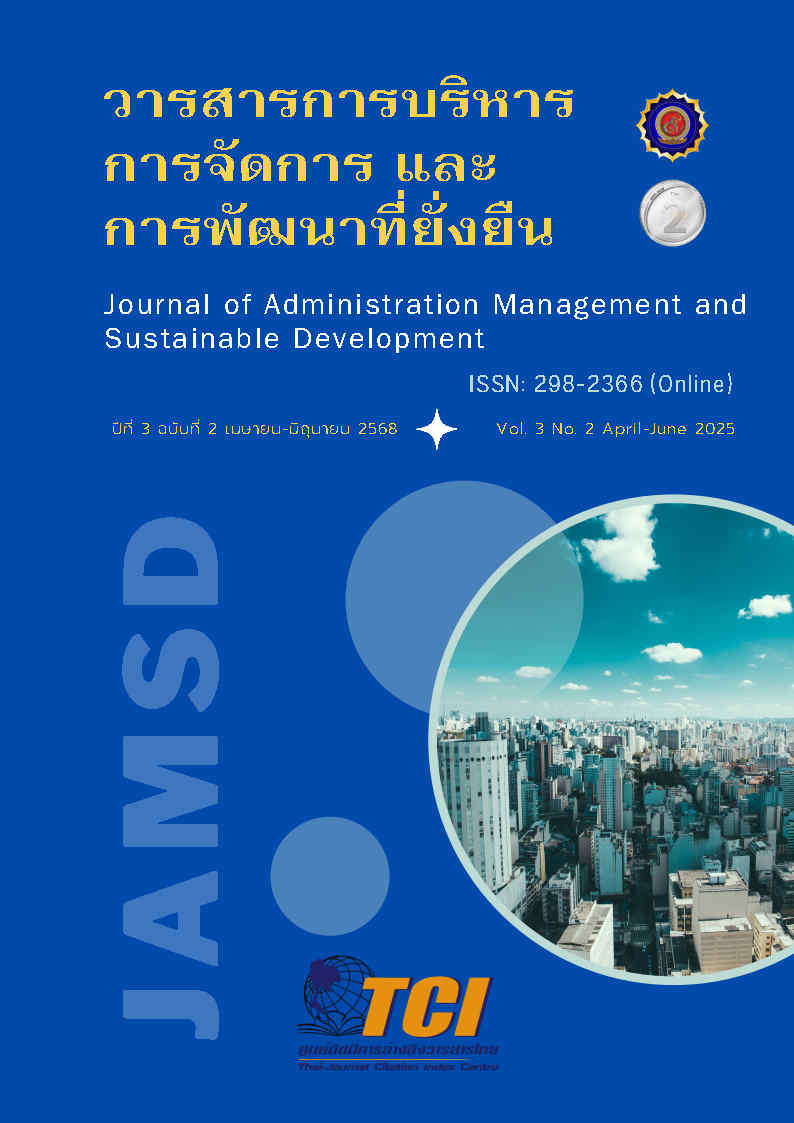The reflection of social inequality through films: “The paradise of thorns”
Keywords:
inequality, semiology, film, The paradise of thornsAbstract
This article analyzes the narrative of the film “The Paradise of Thorns” using semiology to explore the underlying meanings that reflect social inequalities in Thai society. The term “Naam” (thorn) in the title symbolizes the pain and struggle arising from disparities in various dimensions, including economic, social, and gender inequalities. The film highlights the unequal access to opportunities, particularly in rural areas where social stratification is pronounced. Four key themes are examined: 1. Gender and human rights inequalities, as depicted through the struggles of a same-sex couple facing legal restrictions, resulting in the loss of land rights due to the inability to legally marry. 2. Cultural and belief-based inequalities within ethnic groups, where women's roles are confined to caregiving duties. 3. Gender-based limitations that lead to differing opportunities for men and women. And 4. Challenges in accessing state welfare, especially public health services, in rural areas with inadequate infrastructure. This article argues that "Viman Naam" serves as a compelling example of how semiology can be used to portray the profound social inequalities present in the context of Thai society.
References
กาญจนา แก้วเทพ. (2556). สื่อสารมวลชนทฤษฎีและแนวทางการศึกษาพิมพ์ (พิมพ์ครั้งที่ 4). ห้างหุ้นส่วนจำกัดการพิมพ์.
จีดีเอช. (2567, 17 กรกฎาคม). แรงบันดาลใจจากความไม่เท่าเทียมสู่ภาพยนตร์เรื่องล่าสุดจาก GDH ร่วมกับ ใจ สตูดิโอ [วิดีโอ]. Facebook. https://www.facebook.com/watch/?v=488736073707285&ref=sharing.
ฉวีวรรณ ประจวบเหมาะ, สรินยา คำเมือง, สมรักษ์ ชัยสิงห์กานานนท์, บุญสม ชีรณิชย์กุล และอธิตา สุนทโรทก. (2555). ปริศนาวงศาคณาญาติ “ลัวะ” ศูนย์มานุษยวิทยาสิรินธร (องค์การมหาชน).
ชัยวัฒน์ ทวีวงศ์แสงทอง และสุมน อยู่สิน. (2558). การบริหารงานภาพยนตร์หน่วยที่ 6-10. สำนักพิมพ์ มหาวิทยาลัยสุโขทัยธรรมาธิราช.
ไทยพับลิก้า. (2567). World Bank ประเมิน Real GDP ไทยปี 2567 ที่ 2.4% ตามหลังอาเซียน. สืบค้น 1 พฤษภาคม 2568 จาก https://thaipublica.org/2024/10/world-bank-east-asia-and-pacific-economic-update/.
ปริญญา ฉิมบรรเลง, พฤทธิ์ ศุภเศรษฐศิริ และนพดล อินทร์จันทร์. (2568). การประกอบสร้างภาพยนตร์ชายรักชายของเวียดนาม ระหว่าง ปี 2007-2020. Journal of Arts and Thai Studies, 47(1), E4054(1-20).
พระครูวิมลสุวรรณกร (สมพงษ์ จนฺทวโร). (2568). การศึกษากฎหมายการสมรสเท่าเทียมในประเทศไทย: ความเสมอภาคในเพศทางเลือก. วารสารสหวิทยาการนวัตกรรมปริทรรศน์, 8(2), 202–216.
รณภูมิ สามัคคีคารมย์. (2567). การยอมรับของครอบครัวและการรับรู้ผลต่อสุขภาพของชายรักชายในพื้นที่อำเภอเมืองจังหวัดพิษณุโลก. วารสารสหศาสตร์, 24(1), 68–85.
วรัชญ์ตะวันทร์ ชัยรัตน์, ณัฐธิดา คำประเสริฐ และชนณเกษม โคตรบัวศรี. (2567). แนวโน้มและผลกระทบของเนื้อหาภาพยนตร์ไทยในช่วง 5 ปีที่ผ่านมา. วารสารธรรมเพื่อชีวิต, 30(3), 269–289.
วิสุทธิ์ ชลธาร และกฤษดา เกิดดี. (2567). การศึกษาวิเคราะห์ภาพยนตร์ที่มีเนื้อหาว่าด้วยความรุนแรง. วารสารนิเทศศาสตรปริทัศน์, 28(2), 140–148.
สุรชัย ศรีนรจันทร์. (2567). พฤติกรรมการใช้สื่อและผลกระทบจากการท่องเที่ยวตามรอยภาพยนตร์พื้นที่จังหวัดเชียงใหม่ ลำพูน และลำปาง. วารสารวิชาการนิเทศศาสตร์และนวัตกรรม นิด้า, 11(1), 83–100.
Allen, R. C., & Gomery, D. (1985). Film history: Theory and practice. McGraw-Hill Companies.
Barthes, R. (1977). Image, music, text. (Heath, S. Trans.). Fontana Press.
Chandler, D. (2007). Semiotics: The basics (2nd ed.). Routledge.
Eco, U. (1979). A theory of semiotics. Indiana University Press.
Giddens, A., & Sutton, P. W. (2009). Sociology. (6th ed.). Polity Press.
Marx, K. (1903). Das Kapital: Kritik der politischen Oekonomie. Meissner.
Metz, C. (1974). Film language: A semiotics of the cinema. (Taylor, M. Trans.). Oxford University Press.
Monaco, J. (2009). How to read a film: Movies, media, and beyond (4th ed.). Oxford University Press.
Peirce, C. S. (1974). Collected papers of Charles Sanders Peirce (Vol. 5, Weiss, P. Ed.). Belknap Press of Harvard University Press.
Phongpaichit, P., & Baker, C. (2002). Thailand, economy and politics (2nd ed.). Oxford University Press.
Rawls, J. (1999). A theory of justice. Oxford University Press.
Romanow, L. (2012). The women of Thailand. Global Majority E-Journal, 3(1), 44–60.
Saussure, F. de. (2006). Writings in general linguistics. Oxford University Press.
Stam, R. (1992). New vocabularies in film semiotics: Structuralism, post-structuralism and beyond. Routledge.
Weber, M. (1968). Economy and society: An outline of interpretive sociology (Roth, G. & Wittich, C. Eds.). Bedminster Press.
World Bank. (2020). Thailand economic monitor: Thailand in the time of COVID-19. World Bank. https://documents1.worldbank.org/curated/en/456171593190431246/pdf/Thailand-Economic-Monitor-Thailand-in-the-Time-of-COVID-19.pdf.






